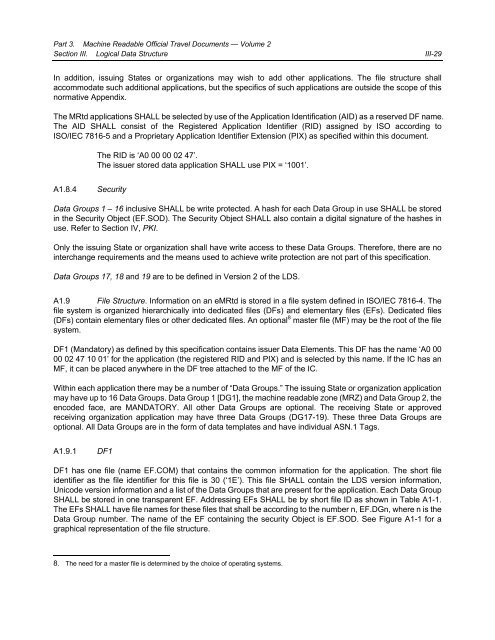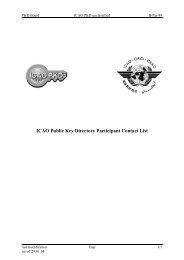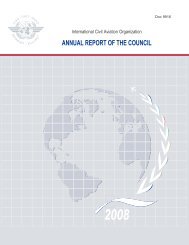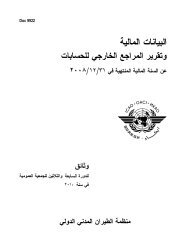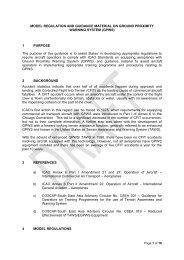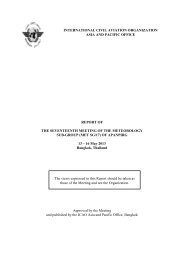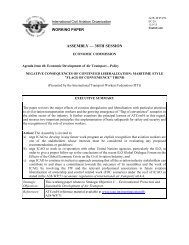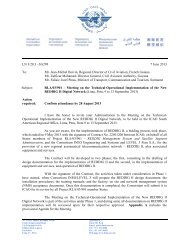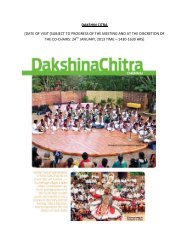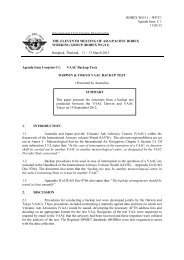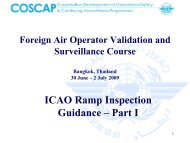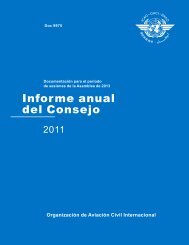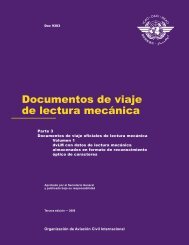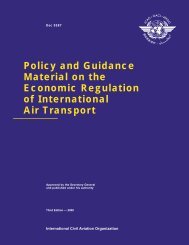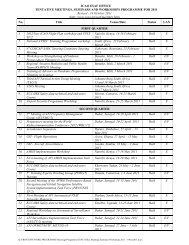Machine Readable Travel Documents - ICAO
Machine Readable Travel Documents - ICAO
Machine Readable Travel Documents - ICAO
Create successful ePaper yourself
Turn your PDF publications into a flip-book with our unique Google optimized e-Paper software.
Part 3. <strong>Machine</strong> <strong>Readable</strong> Official <strong>Travel</strong> <strong>Documents</strong> — Volume 2<br />
Section III. Logical Data Structure III-29<br />
In addition, issuing States or organizations may wish to add other applications. The file structure shall<br />
accommodate such additional applications, but the specifics of such applications are outside the scope of this<br />
normative Appendix.<br />
The MRtd applications SHALL be selected by use of the Application Identification (AID) as a reserved DF name.<br />
The AID SHALL consist of the Registered Application Identifier (RID) assigned by ISO according to<br />
ISO/IEC 7816-5 and a Proprietary Application Identifier Extension (PIX) as specified within this document.<br />
A1.8.4 Security<br />
The RID is ‘A0 00 00 02 47’.<br />
The issuer stored data application SHALL use PIX = ‘1001’.<br />
Data Groups 1 – 16 inclusive SHALL be write protected. A hash for each Data Group in use SHALL be stored<br />
in the Security Object (EF.SOD). The Security Object SHALL also contain a digital signature of the hashes in<br />
use. Refer to Section IV, PKI.<br />
Only the issuing State or organization shall have write access to these Data Groups. Therefore, there are no<br />
interchange requirements and the means used to achieve write protection are not part of this specification.<br />
Data Groups 17, 18 and 19 are to be defined in Version 2 of the LDS.<br />
A1.9 File Structure. Information on an eMRtd is stored in a file system defined in ISO/IEC 7816-4. The<br />
file system is organized hierarchically into dedicated files (DFs) and elementary files (EFs). Dedicated files<br />
(DFs) contain elementary files or other dedicated files. An optional 8 master file (MF) may be the root of the file<br />
system.<br />
DF1 (Mandatory) as defined by this specification contains issuer Data Elements. This DF has the name ‘A0 00<br />
00 02 47 10 01’ for the application (the registered RID and PIX) and is selected by this name. If the IC has an<br />
MF, it can be placed anywhere in the DF tree attached to the MF of the IC.<br />
Within each application there may be a number of “Data Groups.” The issuing State or organization application<br />
may have up to 16 Data Groups. Data Group 1 [DG1], the machine readable zone (MRZ) and Data Group 2, the<br />
encoded face, are MANDATORY. All other Data Groups are optional. The receiving State or approved<br />
receiving organization application may have three Data Groups (DG17-19). These three Data Groups are<br />
optional. All Data Groups are in the form of data templates and have individual ASN.1 Tags.<br />
A1.9.1 DF1<br />
DF1 has one file (name EF.COM) that contains the common information for the application. The short file<br />
identifier as the file identifier for this file is 30 (‘1E’). This file SHALL contain the LDS version information,<br />
Unicode version information and a list of the Data Groups that are present for the application. Each Data Group<br />
SHALL be stored in one transparent EF. Addressing EFs SHALL be by short file ID as shown in Table A1-1.<br />
The EFs SHALL have file names for these files that shall be according to the number n, EF.DGn, where n is the<br />
Data Group number. The name of the EF containing the security Object is EF.SOD. See Figure A1-1 for a<br />
graphical representation of the file structure.<br />
8. The need for a master file is determined by the choice of operating systems.


